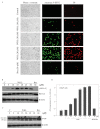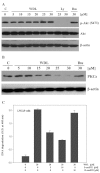Wedelolactone, a medicinal plant-derived coumestan, induces caspase-dependent apoptosis in prostate cancer cells via downregulation of PKCε without inhibiting Akt
- PMID: 23076676
- PMCID: PMC3541032
- DOI: 10.3892/ijo.2012.1664
Wedelolactone, a medicinal plant-derived coumestan, induces caspase-dependent apoptosis in prostate cancer cells via downregulation of PKCε without inhibiting Akt
Abstract
Emerging studies indicate that metabolism of arachidonic acid through the 5-lipoxygenase (5-Lox) pathway plays a critical role in the survival of prostate cancer cells raising the possibility that 5-Lox can be targeted for an effective therapy of prostate cancer. Wedelolactone (WDL), a medicinal plant-derived natural compound, is known to inhibit 5-Lox activity in neutrophils. However, its effect on apoptosis in prostate cancer cells has not been addressed. Thus, we tested the effects of WDL on human prostate cancer cells in vitro. We observed that WDL kills both androgen-sensitive as well as androgen-independent prostate cancer cells in a dose-dependent manner by dramatically inducing apoptosis. We also found that WDL-induced apoptosis in prostate cancer cells is dependent on c-Jun N-terminal Kinase (c-JNK) and caspase-3. Interestingly, WDL triggers apoptosis in prostate cancer cells via downregulation of protein kinase Cε (PKCε), but without inhibition of Akt. WDL does not affect the viability of normal prostate epithelial cells (PrEC) at doses that kill prostate cancer cells, and WDL-induced apoptosis is effectively prevented by 5-oxoETE, a metabolite of 5-Lox (but not by 15-oxoETE, a metabolite of 15-Lox), suggesting that the apoptosis-inducing effect of WDL in prostate cancer cells is mediated via inhibition of 5-Lox activity. These findings indicate that WDL selectivity induces caspase-dependent apoptosis in prostate cancer cells via a novel mechanism involving inhibition of PKCε without affecting Akt and suggest that WDL may emerge as a novel therapeutic agent against clinical prostate cancer in human.
Figures






Similar articles
-
Wedelolactone, an Anti-inflammatory Botanical, Interrupts c-Myc Oncogenic Signaling and Synergizes with Enzalutamide to Induce Apoptosis in Prostate Cancer Cells.Mol Cancer Ther. 2016 Nov;15(11):2791-2801. doi: 10.1158/1535-7163.MCT-15-0861. Epub 2016 Jul 29. Mol Cancer Ther. 2016. PMID: 27474149 Free PMC article.
-
Inhibition of 5-lipoxygenase triggers apoptosis in prostate cancer cells via down-regulation of protein kinase C-epsilon.Biochim Biophys Acta. 2011 Dec;1813(12):2108-17. doi: 10.1016/j.bbamcr.2011.07.015. Epub 2011 Jul 30. Biochim Biophys Acta. 2011. PMID: 21824498 Free PMC article.
-
OXER1, a G protein-coupled oxoeicosatetraenoid receptor, mediates the survival-promoting effects of arachidonate 5-lipoxygenase in prostate cancer cells.Cancer Lett. 2013 Aug 9;336(1):185-95. doi: 10.1016/j.canlet.2013.04.027. Epub 2013 May 2. Cancer Lett. 2013. PMID: 23643940 Free PMC article.
-
A comprehensive review on wedelolactone: natural sources, total synthesis, and pharmacological activities.Chin J Nat Med. 2025 Feb;23(2):169-181. doi: 10.1016/S1875-5364(25)60821-1. Chin J Nat Med. 2025. PMID: 39986693 Review.
-
The potential therapeutic effects of Galbanic acid on cancer.Pathol Res Pract. 2023 Aug;248:154686. doi: 10.1016/j.prp.2023.154686. Epub 2023 Jul 13. Pathol Res Pract. 2023. PMID: 37487315 Review.
Cited by
-
Nanomaterials as Inhibitors of Epithelial Mesenchymal Transition in Cancer Treatment.Cancers (Basel). 2019 Dec 19;12(1):25. doi: 10.3390/cancers12010025. Cancers (Basel). 2019. PMID: 31861725 Free PMC article. Review.
-
Wedelolactone, an Anti-inflammatory Botanical, Interrupts c-Myc Oncogenic Signaling and Synergizes with Enzalutamide to Induce Apoptosis in Prostate Cancer Cells.Mol Cancer Ther. 2016 Nov;15(11):2791-2801. doi: 10.1158/1535-7163.MCT-15-0861. Epub 2016 Jul 29. Mol Cancer Ther. 2016. PMID: 27474149 Free PMC article.
-
Modelling pancreatic β-cell inflammation in zebrafish identifies the natural product wedelolactone for human islet protection.Dis Model Mech. 2019 Jan 23;12(1):dmm036004. doi: 10.1242/dmm.036004. Dis Model Mech. 2019. PMID: 30679186 Free PMC article.
-
In vitro and in vivo anti-cancer activity of formononetin on human cervical cancer cell line HeLa.Tumour Biol. 2014 Mar;35(3):2279-84. doi: 10.1007/s13277-013-1302-1. Epub 2013 Nov 24. Tumour Biol. 2014. PMID: 24272199
-
A Standardized Wedelia chinensis Extract Overcomes the Feedback Activation of HER2/3 Signaling upon Androgen-Ablation in Prostate Cancer.Front Pharmacol. 2017 Oct 10;8:721. doi: 10.3389/fphar.2017.00721. eCollection 2017. Front Pharmacol. 2017. PMID: 29066975 Free PMC article.
References
-
- Govindachari T, Nagarajan K, Pai B. Wedelolactone from Eclipta alba. J Sci Indust Res. 1956;15B:664–665.
-
- Wagner H, Geyer B, Kiso Y, Hikino H, Rao GS. Coumestans as the main active principles of the liver drugs Eclipta alba and Wedelia calendulacea. Planta Med. 1986;52:370–374. - PubMed
-
- Singh B, Saxena AK, Chandan BK, Agarwal SG, Anand KK. In vivo hepatoprotective activity of active fraction from ethanolic extract of Eclipta alba leaves. Indian J Physiol Pharmacol. 2001;45:435–441. - PubMed
-
- Roy RK, Thakur M, Dixit VK. Hair growth promoting activity of Eclipta alba in male albino rats. Arch Dermatol Res. 2008;300:357–364. - PubMed
Publication types
MeSH terms
Substances
Grants and funding
LinkOut - more resources
Full Text Sources
Medical
Research Materials
Miscellaneous

